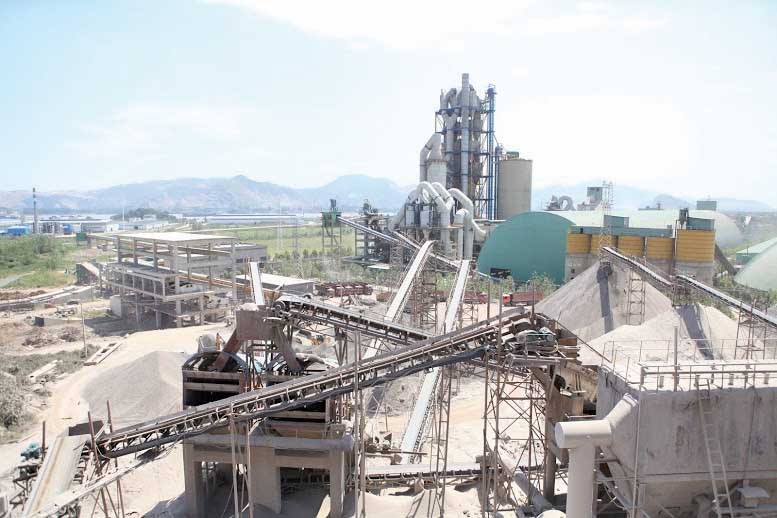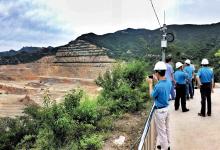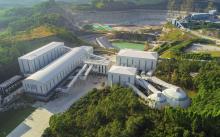
China has more demand for aggregates than any other nation on earth, but it’s falling amid intense economic pressures. Guy Woodford reports.
According to David Zhao and his team at China Aggregates Net (CAN), which specialises in independent Chinese aggregates market analysis and statistics, the development of the aggregates industry in the world’s most populated country is closely linked to the performance of the domestic construction and construction equipment market.
“With the decrease in natural sand reserves, manufactured sand is gradually capturing the market. The environment is also taking an increasingly important role in the aggregates industry,” says Zhao. “Natural sand in China is mined mostly by hand. When a machine is used to mine or quarry natural sand, sand quality rapidly increases. While manufactured sand is taking a larger proportion of the market, the aggregate industry standard for it is continually being perfected.
Zhao continues: “We’ve also noted how there is loud demand for aggregate for high-quality and long duration concrete, while construction waste utilisation technology has matured, and the city itself has become the mine for aggregate raw materials.”
China’s aggregates industry has, says Zhao, only been developing for a short period, presenting numerous problems for those involved in it. “Aggregate companies meet difficulties in their development and transformation due to a lack of industry standards, while technology and environment consciousness still puzzles the whole industry. Added to this is the long-term lack of government attention and statistics data. It all creates confusion and troubles for company owners.”
With its population of 1.3 billion people and globally renowned thirst for new housing and other infrastructure, it’s little surprise that China has for many years topped the individual nation table for aggregate demand.
As CAN notes, the likelihood of big profit has driven enterprises in recent years to launch aggregate processing plants with huge production capacity. In 2014, the Chinese government encouraged high-quality aggregate and environmental friendly plants, which created unparalleled pressure on middle- and small-sized companies, with many of them subsequently closed due to environment pollution and poor safety measures.
Zhao and his CAN colleagues highlight how the Chinese economy has continued its downward trajectory in 2015, reducing the number of construction projects and, as such, aggregate market demand.
“This has also created a self-adjustment opportunity for China’s aggregates industry,” says Zhao. “Meagre profit has taken the place of previous excessive profit, and instead of natural sand mining, massive aggregate base for manufactured sand is the only choice for the market.”
He continues: “Recently many state-owned enterprises have brought advanced technology and management to the aggregates industry, and with their sufficient capital and mine reserves, they established production plants with energy-saving and environmental protection facilities, enabling them to achieve comprehensive utilisation of resources.”
Despite China’s aggregates industry now starting to take heed of the green agenda, Zhao says it still has a long way to go.
Summing up, he adds: “In 2013, China’s aggregates market consumption was around 12 billion tonnes. In 2014, it increased by 25% to 15 billion tonnes. In 2015 we have seen the adjustment of China’s macro-economy and downward pressure. It is now estimated that aggregates market consumption will decline by a relatively large number.”
Emphasising the CAN-stated link between China’s current, more limited, aggregates demand and the demand for construction equipment is the latest research by Off Highway Research (OHR), a leading construction equipment global market analysis firm.
The OHR forecasts annual average Chinese construction equipment sales for the period 2015-19 to be around 160,021 – almost exactly half of the 319,399 sales achieved in the years 2010-14. Within the overall figures, wheeled loader sales are tipped by OHR to plummet to an annual average of 64,000 from 2015-19 – from 162,782 in the period 2010-14. Crawler excavator sales are also expected to average 58,800 from 2015-19, compared to 113,244 in the period 2010-14.
Despite the slump in Chinese construction equipment sales, there has been a huge rise in unit production levels, creating significant overcapacity. Latest OHR figures show the annual average of units produced in the years 2010-14 at 356,793 - compared to 225,153 over the 2005-9 period.
In a speech at a LiuGong event in June 2015, David Phillips, OHR’s managing director, said there was an urgent need to cut production overcapacity by 50% due to lower demand. He said OEMs had in the past been overly reliant on local government backing, a state of affairs which, he said, needed to change. Chinese firms also, he said, needed to focus on profitability, not just market share. This he nicely equated to Profits = Sanity; Volumes = Vanity. Phillips also said the climate of easy financing for construction equipment purchases needed to stop – pointing out how this practice had damaged the US and European construction equipment sector in previous years.
As noted previously in Aggregates Business International, with domestic demand facing such a stark decline, it’s no surprise how major Chinese OEMs such as
But again, as the likes of OHR’s David Phillips has warned, most international markets will buy Chinese products on price, rather than because they want to. Saying that, if Chinese firms’ considerable efforts to improve their customer service support pay off, this could ease any possible misgivings among many potential international customers.
Shane Shen, VP sales area China, Sandvik Construction, says: “In China, aggregate demand is driven by two factors: urbanisation and infrastructure construction projects. Due to the government’s investment reduction on infrastructure, and sluggish real estate demand in China, the current market has reduced in comparison to 2014. This trend looks likely to continue in the next few years.”
Emphasising the ongoing importance of the Chinese market to the sector giant, Shen adds: “In order to provide benefits in the long-term, both from a productivity and environmental perspective, the Chinese government is consolidating the output of the quarrying industry. This has led to the converting of small projects to larger-scale ones, and led directly to increased demand for high-quality crushers, for example, with a production capacity of between 1,000 tonnes/hour - 3,000 tonnes/hour. This situation is now providing more opportunities for Sandvik Construction equipment, especially to the middle level market, with the demand rising noticeably.”
Shen also highlights another potential key Chinese market shift. “A very tangible development that has created opportunities for Sandvik Construction VSI’s is that the use of river sand is now forbidden in local construction projects. This has created an opportunity to supply equipment that has been specifically developed to manufacture sand. This is not only excellent news from an environmental perspective, but also produces a variety of benefits in construction as using Sandvik VSI’s in this application produces a superior sand product than naturally occurring sand.”
Ziqian Li,
As noted by CAN, Li says that it will be more difficult in China to get a quarry licence in future as the government is introducing new legislation to make sites more environmentally friendly, low-energy, and safer. “It will be more big quarries and less small quarries, currently more and more 2,000tonnes per hour quarries are being planned,” he adds.
Li continues: “In the past, Chinese cement companies only focused on cement production. Now Chinese companies are focusing more on aggregate production and ready-mixed concrete using their cement mines, which can bring them more profit. This is similar to what big international cement companies such as









